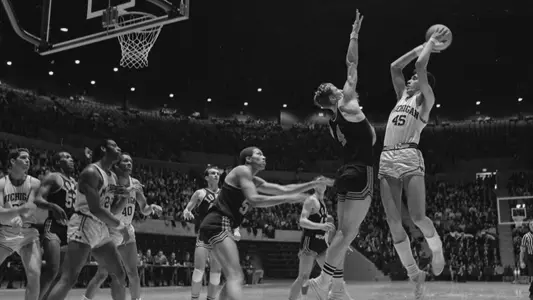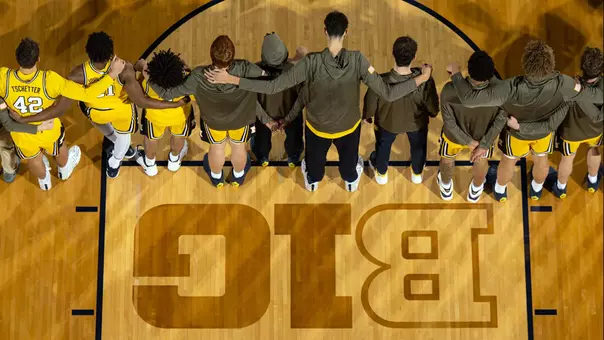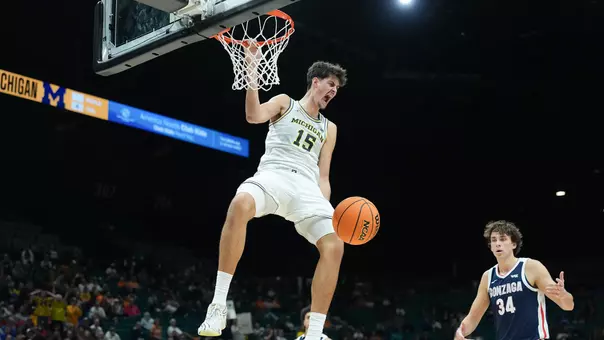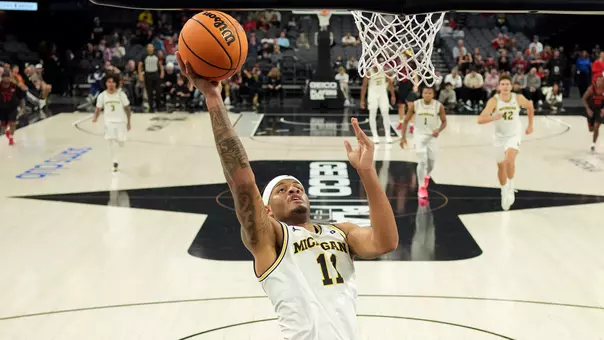
Tomjanovich, 'The Shoemaker's Son,' Changed Shot at Michigan on Way to Hall of Fame
8/26/2020 12:30:00 PM | Men's Basketball, Features
By Steve Kornacki
ANN ARBOR, Mich. -- "The Shoemaker's Son" was told an athletic scholarship was his ticket out of the inner city and to a prosperous life. He put his nose to the grindstone in both the classroom and on the asphalt basketball courts, also shooting endlessly on the homemade backboard in the chuckhole-dotted alley behind his home.
University of Michigan coach Dave Strack was one of many spotting his immense talents and signed him, launching the All-American's career as a record-setting Wolverine. Rudolph "Rudy" Tomjanovich Jr., became the second overall pick in the 1970 NBA Draft, made five All-Star teams for the Houston Rockets, coached two NBA championship teams for that same franchise, and coached the 2000 U.S. Olympic gold medal team.
Now, at age 71, and retired, Tomjanovich is excited about entering the Naismith Memorial Basketball Hall of Fame as the first Wolverine to be honored. The enshrinement ceremony was supposed to take place Saturday (Aug. 29) in Springfield, Mass., but due to the COVID-19 pandemic, the event has been rescheduled for May 13-15, 2021, in Uncasville, Conn.
"It was a revelation to me that I was the first Michigan guy in the Basketball Hall of Fame," Tomjanovich said in a phone interview with MGoBlue.com. "I was shocked because I thought Cazzie (Russell) was already in (Russell is in the College Basketball Hall of Fame).
"Being in the Hall of Fame is beyond my greatest dreams. I always dreamed about being good at basketball, and just making teams was a success. But, then, being able to start, be an All-Star, was really special."
Those "dreams" took root in his hometown of Hamtramck, Mich., surrounded by Detroit on each border. He said his father and namesake worked hard and "was a jack of many trades and a master at one," adding that Rudy Sr. was the community's shoemaker and repaired shoes when he was in grade school.
"Dad had a cute little hut I passed on my way to school where he fixed and made shoes," Tomjanovich said. "I was known for many years as 'The Shoemaker's Son.' The thing is, he was a very good shoemaker. But he put himself out of business because after he made or fixed a shoe, you weren't going to need work on that shoe for years. So, he didn't have the customers. And we're talking about a blue-collar neighborhood where people didn't buy extra pairs of shoes."
Rudy wore "hand-me-downs" and did without many things, saying, "We only got a telephone because I said, 'We're going to have to have a place where they can call if I'm going to get a scholarship.' So, we put in a phone."
Countless college coaches ended up calling, but only Strack received the desired answer. Freshmen were not eligible for to play varsity in those days, but Tomjanovich played on the freshman team. Part of their schedule featured games before varsity contests at Yost Fieldhouse against members of the football team, and he recalled gaining toughness from playing against John Rowser, a gritty defensive back/halfback, who was a senior and would play 10 seasons in the NFL, becoming a member of the Green Bay Packers' Super Bowl II champions.

Tomjanovich came out of the tunnel at brand new Crisler Arena like a rocket as a sophomore. He had a team-high 17 points, tied M.C. Burton's school record with 27 rebounds and blocked 13 shots in the first game at Crisler, which opened Dec. 6, 1967, as the University Events Building.
"Sometimes I look at those stats and can't believe them," said Tomjanovich. "You have to be a greedy son of a gun to get those."
He was excited to play Kentucky in that game because he had read all about coach Adolph Rupp's highly-ranked team in a basketball magazine his mother, Catherine, bought for him.
"We were going to be playing against Dan Issel and Mike Casey," said Tomjanovich. "I was so nervous that I took a jump shot from the free-throw line that I shot so hard that I got one of those rebounds back at the free-throw line. And, it's not official, because that stat wasn't kept then, but somebody watching film said I had 13 blocked shots in that game, too.
"I really could jump, but I was so damn nervous that day. I jumped so much in that game that the next day, when I got up, I had plantar fasciitis in both feet and couldn't stretch out those tendons."
Two days later, the Wolverines were playing at the University of Detroit, and Tomjanovich remained in pain. He had no spring in his legs and was not going to play. However, his Hamtramck High coach, John Radwanski, pulled him aside outside the Calihan Hall locker room and implored him to find a way to play in front of so many friends and family -- as well as Titans star Ralph Brisker, his high school teammate. And with the help of the team trainer, Tomjanovich played.
"But I couldn't shoot my jump shot," he said. "I shot almost a set shot, and all these very soft shots were going in. So, I learned that I didn't have to jump that high. Doing that just made the shot harder. You talk about growing as a player; I never even thought about that. I learned I didn't have to waste all my energy on the jump, and that if you had to jump that high, it probably wasn't a good shot. I was lucky I went through that that early in my career."
"Rudy T.," a 6-foot-8 power forward who also played center for the Wolverines, said his shot changed forever that day. But there was another critical shooting adjustment made during his junior season from a lesson learned in Michigan assistant coach Fred Snowden's basketball class.
"Fred told me, 'You know, your shot is a little flat. Have you tried using a bank shot on a (45-degree) angle? Why don't you try it?' Within a week, I tied the scoring record with 48 points. I was as surprised as anybody when I started shooting these bankers. And I could shoot it hard, but if I had spin on it, it would hit that spot (on the backboard) and it would be like a marshmallow. 'Boom!' it would hit and fall softly into the basket.
"That was another big revelation."
Tomjanovich made 21-of-34 shots, an astounding 62-perent accuracy, on the night of Jan. 7, 1969, against Indiana to score 48 points, a total that has not been matched or topped by a Wolverine in the 51 years since. It equaled the record set in 1966 by Russell.
"I hadn't been comfortable shooting from 18 feet and out from angles before that," said Tomjanovich. "But now, that was where I wanted to go. If I got to the right spot, I could just fling it, and it was going in the basket.
"That opened up the game big time for me. I was just so happy I had found this new weapon. I always tried to be open-minded to add new things to my arsenal, even later in my career (at Houston). We had Moses Malone, and the coaches had me and all the big guys working on jump hooks and step hooks in the paint. That allowed me to do big things inside against bigger, stronger players. With the hook shot, I could shield myself from the defender with my body."
He scored 40 one month later at Illinois, and tallied 42 against Utah as a senior. A prolific scorer had evolved, and his 25.1-point career average is second at Michigan only to Russell's 27.1.

Russell's No. 33 was the first retired at Crisler, known as "The House Cazzie Built," and Tomjanovich's No. 45 became the second. When he came back Feb. 8, 2003, for the ceremony, fans chanted, "RUDY! RUDY! RUDY!"
Tomjanovich didn't wear No. 45 until coming to Michigan.
"I don't know how I ended up getting it," said Tomjanovich, "but I just thought 45 looked right on me. I know that might sound funny, but I just felt really comfortable with 45.
"It was just a tremendous honor having it retired. You know, I look back on my days at Michigan, and I don't know how I would've done it if I didn't have those four years where you get away from home, you're learning how to balance a checkbook and be on your own, and just grow as a human being. It was such an important time for me.
"And then to go to the NBA, which was still a big jump after four years at Michigan, I don't know how these young guys (today) handle it without that experience."
Somebody could score 49 points to break the single-game scoring record he shares with Cazzie, but it's difficult envisioning anybody even matching his 30-rebound game against Loyola at Chicago Stadium on Feb. 1, 1969. If that were to happen, though, his career mark of 1,039 rebounds seems untouchable.
Tomjanovich and fellow All-Americans Phil Hubbard and Chris Webber are the only Wolverines with two seasons in which they grabbed 340-plus rebounds. But since Tomjanovich's teams never reached the NCAA Tournament, he never exceeded 24 games in one season, far fewer than Hubbard and Webber.
However, the odds of a great rebounder staying even three seasons in this one-and-done age of college basketball is hard to imagine.
"The good players will be gone before they could get enough," said Tomjanovich, whose 14.4 rebound average also is Michigan's career record. "But rebounding was my way of life at that time. That was the only way I knew how to play."
He played for Strack and then two seasons for Johnny Orr in Ann Arbor.
"The experience I got at Michigan was invaluable," said Tomjanovich, both the team captain and MVP as a senior. "I came from Hamtramck, which was only 42 miles away, but was in a whole different world. It was a culture shock for me at first, but it was exciting. I felt like a fish out of water, but Dave Strack was a great guy. I really liked him. He had great success with Cazzie, Oliver Darden, Larry Tregoning and Bill Buntin. He ran the same offense for Cazzie that he did for our team, and that wasn't the strength of our team.
"Then Johnny Orr came in, and he said, 'Guys, we're going to push that ball up the court. On defense, you guys have got the wrong idea. When they score, I see you guys getting your dobbers down. I don't want nobody getting their dobber down. Get that ball out of the basket and throw that thing down the court! We're going to get it right back.' I tried not to get my dobber down (laughter)."

Rudy T. thrived under Orr even if those teams never did. They played some of the toughest schedules in the nation, but did well just to break even. Michigan was 13-11 overall and 7-7 for fourth place in the Big Ten in 1968-69, Tomjanovich's only winning college season.
However, there were games like the one at Crisler against No. 8-ranked Marquette on Dec. 8, 1969, when Tomjanovich was enough to beat an elite team. He recalled Marquette coach Al McGuire sending some of his players over to Michigan's pregame huddle to shake his hand.
"I don't know if he was trying to get into my head," said Rudy T. "But I got it going in that game, and I made one of those bank shots. I faked my guy up into the air, and he was coming down, I was coming up into him, and he hit me in the arm and I just flung it up. It went in and I made the three-point play (by adding the free throw after the foul)."
Tomjanovich scored 32 points and grabbed 13 rebounds (both game-highs) in an 86-78 victory, and recalled: "McGuire, after that game, gave me a great endorsement. It was like the headline: 'McGuire Says Tomjanovich is Great,' and later that year, when I was negotiating my contract in the NBA, he was in the NIT at Madison Square Garden, and I thanked him for his great praise."
Madison Square Garden was always part of Rudy T.'s basketball dreams.
"There was an alley behind my house," said Tomjanovich. "We played games back there, and we would play in rain drain pipes, the gutters, with a tennis ball. But as I got to be a better player, the older guys in the neighborhood found a kitchen table that was thrown out. It was shaped like a rectangular backboard, and they chipped in and bought a rim with a nylon net to attach to it and put it on my garage. They did a good job. It was exactly 10 feet and they leveled it.
"Because the guy on the other side of the alley didn't have a garage, (the court) went out about 40 feet from my basket, like a good half court. The problem was that the alley was nothing but chuckholes. So, we couldn't dribble or play games. I would just shoot the ball there, and have to chase it when it came down on a chuckhole and bounced down the alley. I spent hours and hours shooting there, and it was a big help."
He also was fortunate that his junior high school had numerous outdoor courts, and still recalls with joy the day one of the older kids was injured and he was called into a game on one of two regulation courts.
"It was like I went to Madison Square Garden," said Tomjanovich. "I sat on a bench after that game, pondering how lucky I was. It was right after my freshman year."
He played at Hamtramck High with not only Ralph Brisker, but John Brisker, a high school All-American who went onto become an enforcer with the ABA's Pittsburgh Condors before playing for the Seattle SuperSonics. Good competition was easy to find in an area rich with hoops talent.
Rudy's boyhood heroes were future Detroit Tigers Hall of Famer Al Kaline and his cousin, Mark Modich, who was two years older and had three hits in the championship game of the 1959 Little League World Series won by Hamtramck in Williamsport, Pa.
"I was too young to be on that team," said Tomjanovich, "but he made me feel like I was out there, too. He had such humility and told me all the stories. He ended up being a great teacher in Royal Oak for over 30 years, and has always been my hero. People always thought I was a hero, but this guy was the hero, teaching kids in elementary school. He was such a cool guy that he made school fun for them, improving their lives."
Mark's father, Joe, was Rudy's uncle, and provided him a goal that made all the difference. He told Rudy that he was a "good student" but that a college education wasn't affordable for his family unless he could earn an athletic scholarship.
"Uncle Joe said, 'Keep your grades up and find a sport that you're good enough in, and maybe you can get to college.' So, Uncle Joe exposed me to all the sports. He took me and my mother and sister for rides on the weekends out of the inner city into the northern suburbs around 24 or 25 Mile Road, showing us there was another world out there."
Rudy T. found that "world" 42 miles west in Ann Arbor, and those four years opened up the gates to NBA greatness that eventually brought him to the doorsteps of the Hall of Fame in Springfield.
• Part 2: How Hall of Famer Tomjanovich Became NBA Playing, Coaching Success After Michigan










